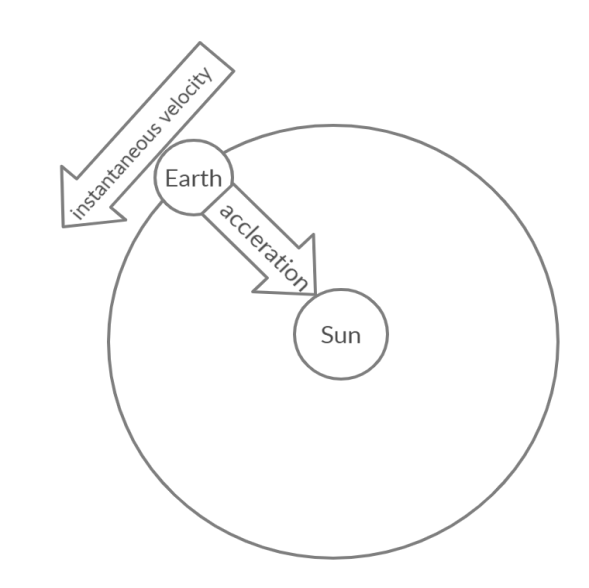Answer
404.1k+ views
Hint: Acceleration, velocity and displacement are combined with a simple law. That is, the rate of change of velocity with respect to time is acceleration and the rate of change of position with respect to time is velocity.
Formula used: Distance covered by an acceleration object can be written as: \[x = \dfrac{1}{2}a{t^2}\]
Complete step by step answer:
(a) Acceleration is the rate of change of velocity with respect to time. Even if the velocity of an object becomes zero (for a moment) acceleration is considered to be non-zero. For example, in a pendulum, the velocity is zero as it reverses its direction. But it has to travel backwards due to the kinetic energy and the restoring force stored in it. At that instant of time, the acceleration is non-zero.
(b) Consider a ball moving with constant velocity (horizontally) in a downward direction with constant downward acceleration ‘-g’. Then, according to equation (1), the distance covered by the ball can also be written as \[x = \dfrac{1}{2}a{t^2}\]. But here, the acceleration is ‘-g’. Therefore, \[x = \dfrac{1}{2}( - g){t^2}\]. Negative sign is used because force is directed downwards. This is the example of the case when the velocity is opposite in direction to the acceleration.
(c) Acceleration produced by the rate of change of velocity when the velocity is changing its direction is called centripetal acceleration. For example, the planetary motion. Consider the motion of earth around the sun. The force and the acceleration on earth is always towards the sun, not around the sun. In this case, the velocity is perpendicular to the acceleration.

Note:
The situation where the velocity of a particle is zero with non-zero acceleration can also be thought of as an example when the ball is thrown vertically upwards. After sometime, it starts falling vertically downwards. When the ball reverses its direction, the velocity becomes zero but the acceleration is still not zero.
Formula used: Distance covered by an acceleration object can be written as: \[x = \dfrac{1}{2}a{t^2}\]
Complete step by step answer:
(a) Acceleration is the rate of change of velocity with respect to time. Even if the velocity of an object becomes zero (for a moment) acceleration is considered to be non-zero. For example, in a pendulum, the velocity is zero as it reverses its direction. But it has to travel backwards due to the kinetic energy and the restoring force stored in it. At that instant of time, the acceleration is non-zero.
(b) Consider a ball moving with constant velocity (horizontally) in a downward direction with constant downward acceleration ‘-g’. Then, according to equation (1), the distance covered by the ball can also be written as \[x = \dfrac{1}{2}a{t^2}\]. But here, the acceleration is ‘-g’. Therefore, \[x = \dfrac{1}{2}( - g){t^2}\]. Negative sign is used because force is directed downwards. This is the example of the case when the velocity is opposite in direction to the acceleration.
(c) Acceleration produced by the rate of change of velocity when the velocity is changing its direction is called centripetal acceleration. For example, the planetary motion. Consider the motion of earth around the sun. The force and the acceleration on earth is always towards the sun, not around the sun. In this case, the velocity is perpendicular to the acceleration.

Note:
The situation where the velocity of a particle is zero with non-zero acceleration can also be thought of as an example when the ball is thrown vertically upwards. After sometime, it starts falling vertically downwards. When the ball reverses its direction, the velocity becomes zero but the acceleration is still not zero.
Recently Updated Pages
What number is 20 of 400 class 8 maths CBSE

Which one of the following numbers is completely divisible class 8 maths CBSE

What number is 78 of 50 A 32 B 35 C 36 D 39 E 41 class 8 maths CBSE

How many integers are there between 10 and 2 and how class 8 maths CBSE

The 3 is what percent of 12 class 8 maths CBSE

Find the circumference of the circle having radius class 8 maths CBSE

Trending doubts
Which are the Top 10 Largest Countries of the World?

Fill the blanks with the suitable prepositions 1 The class 9 english CBSE

One cusec is equal to how many liters class 8 maths CBSE

Differentiate between homogeneous and heterogeneous class 12 chemistry CBSE

Difference between Prokaryotic cell and Eukaryotic class 11 biology CBSE

Give 10 examples for herbs , shrubs , climbers , creepers

The Equation xxx + 2 is Satisfied when x is Equal to Class 10 Maths

One Metric ton is equal to kg A 10000 B 1000 C 100 class 11 physics CBSE

Change the following sentences into negative and interrogative class 10 english CBSE



